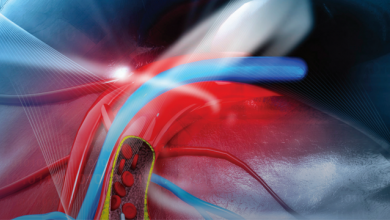Search results
Author(s):
Joost Daemen
,
Paolo Canova
Added:
2 years ago
Contemporary invasive imaging techniques improve the detection of coronary details and have great potential for improving clinical outcomes, due the lower risk of in-stent restenosis and thrombosis. Thiswebinar seriesprovides an overview of the current use of intravascular ultrasound (IVUS) and optical coherence tomography (OCT), the relative advantages of each technique and real-world insight…
View more
Author(s):
Jacek Bil
,
Robert Gil
,
Dobrin Vassilev
Added:
8 years ago
Author(s):
Gérard Finet
,
Gilles Rioufol
Added:
3 years ago
“Nothing comes to us except falsified and altered by our senses.”
Michel de Montaigne (1533–1592)
Coronary angiography (CA) has been performed in cardiology centres for more than 50 years. The diagnosis it provides soon became the gold standard in coronaropathy. It is a purely anatomic diagnosis, and this approach has made a deep mark on cardiology, although the need for a prior non-invasive…
View more
Author(s):
Matthew J Budoff
,
Ambarish Gopal
Added:
3 years ago
Over the past decade, great strides have been made in the field of cardiac imaging, particularly in cardiac computed tomography (CT) to view the coronary artery lumen and plaque.1 Performance of cardiac CT angiography (CTA) has been challenging, given rapid cardiac motion, small vessel diameters, tortuous anatomical patterns and overlapping cardiac structures. Current 64- multi-row detector…
View more
Author(s):
Krishnaraj S Rathod
,
Stephen M Hamshere
,
Daniel A Jones
,
et al
Added:
3 years ago
Coronary angiography has been the gold standard technique for evaluating coronary arterial disease for the past 50 years. Increasingly, however, realisation of the limitations of coronary angiography, mainly the inability to supply information regarding the coronary wall, has prompted the design and development of adjunctive technologies to better evaluate not just luminal disease but also the…
View more
Author(s):
Yun Zhang
,
Cheng Zhang
,
Wen Qiang Chen
,
et al
Added:
3 years ago
Cardiovascular disease is the most common cause of death not only in developed countries, but also in developing countries such as China. According to medical statistics published in 2003, there was one cardiovascular death every 16 seconds in China compared with one only every 34 seconds in the US.1 Most of these patients died suddenly without any warning symptoms. Recent studies have proved…
View more
Author(s):
Jacqueline Saw
Added:
3 years ago
Spontaneous coronary artery dissection (SCAD) is increasingly recognised as an important cause of myocardial infarction (MI), especially in younger women. It is defined as a non-traumatic and non-iatrogenic separation of the coronary artery wall, which creates a false lumen that may or may not be in continuity with the true lumen. Although conventionally SCAD may be atherosclerotic or non…
View more
Author(s):
Salvatore Brugaletta
,
Hector M Garcia-Garcia
,
Patrick W Serruys
Added:
3 years ago
The identification of vulnerable plaques has been a longstanding challenge for interventional cardiologists. Plaque composition is regarded as an important feature for assessment of plaque vulnerability. Histopathologists have in particular shown that the type of plaque most commonly prone to rupture in vivo is the thin-cap fibroatheroma (TCFA), in which the presence of lipid core (also called…
View more
Author(s):
Gilles Rioufol
Added:
3 years ago
Coronary artery adventitia was long considered to be a purely supportive and nutritive tissue, and its role in the natural history of coronaropathy was thus neglected. However, recent studies have highlighted a dynamic role played by the adventitia, and especially by its vasa vasorum (VV), in the genesis of atherosclerosis,1–3 atherothrombotic events4,5 and restenosis following balloon…
View more
Author(s):
Joost Daemen
Added:
7 years ago










 « First
« First